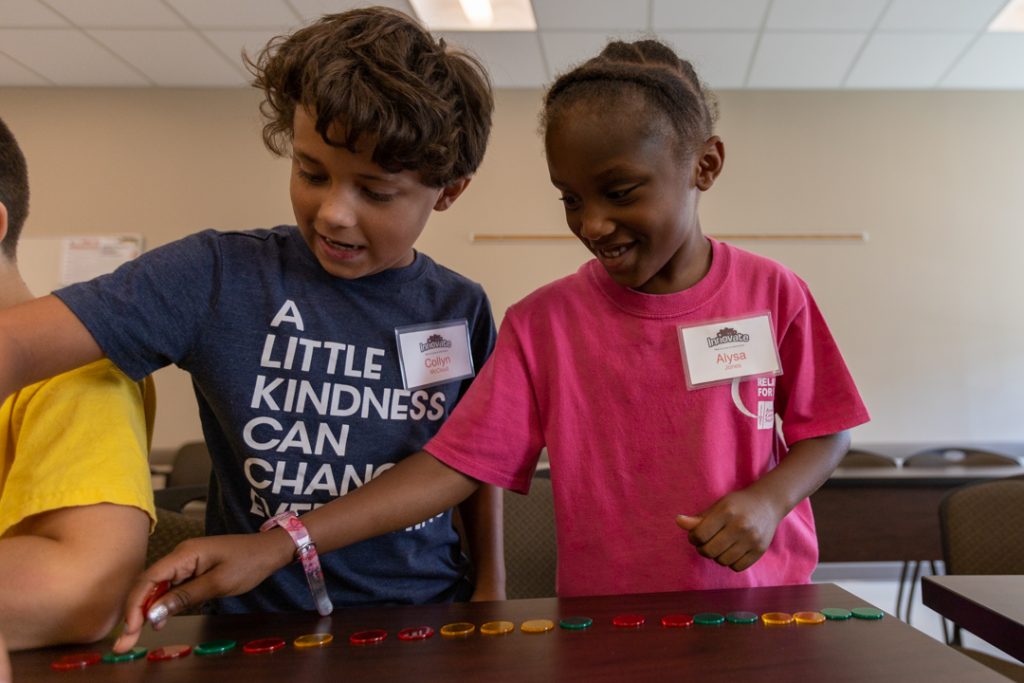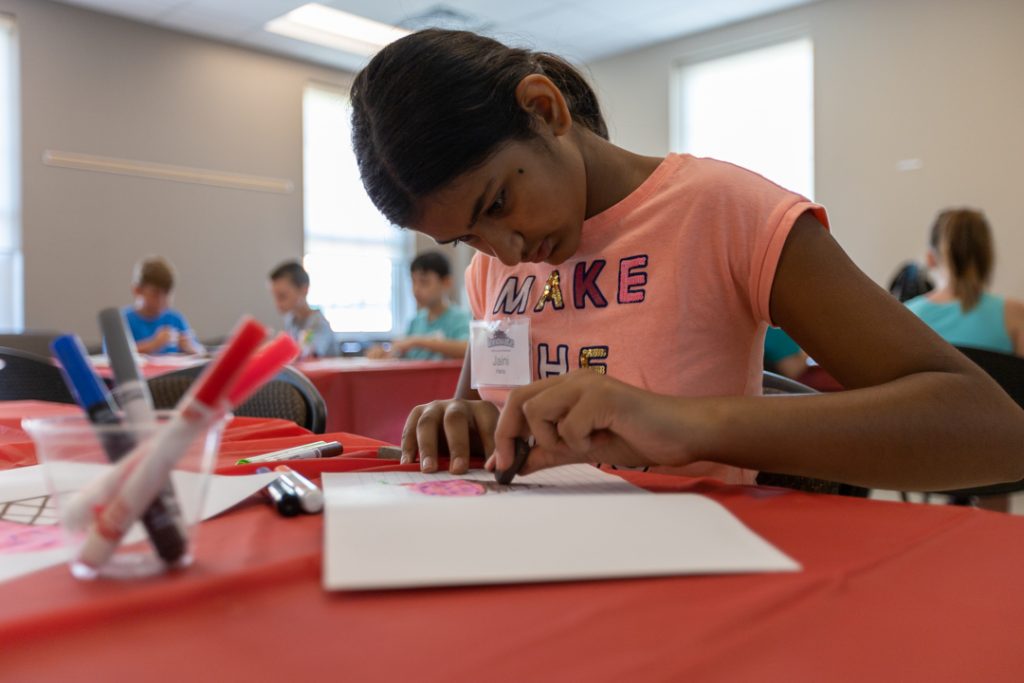 by Erika Solberg
by Erika Solberg
At Camp Innovate, the spirit of innovation is at work not only in what we teach but how we teach it. We want our high-ability, high interest third through fifth graders to have choice in what they do in class, and we want our activities to be “minds on” as well as “hands on” so that students have the power to learn as much as they want and as much as they are able.
Student Choice
Mary Evans makes sure her Language Arts students have a lot of opportunities to express themselves in speaking and in writing. On Tuesday, she began class by reading a book that changes the tale of The Three Billy Goats Gruff into a story about taking care of the environment. Using the book, The Three Fishing Brothers Gruff, as a starting point, Mary lead the students in a discussion of ways humans harm the ocean, such as by littering, and the students then thought of alternatives to single-use items like cloth napkins instead of a paper or metal straws instead of plastic. Next, they brainstormed in small groups about ways to reuse single-use items. Ideas included making a plastic soda bottle into an hourglass, plastic bottle rings into bracelets, and a plastic bag into a Halloween candy carrier. For the last part of class, students chose from different project ideas (see photos). Results include poems like the one pictured.
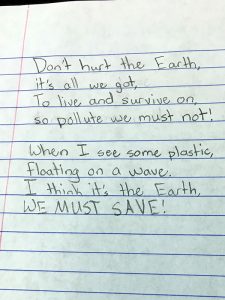

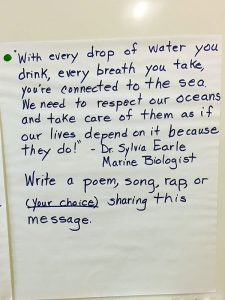 By encouraging the students to think, create, and communicate in a variety of ways, Mary ensured that the students stay engaged and pursue ideas that intrigue them.
By encouraging the students to think, create, and communicate in a variety of ways, Mary ensured that the students stay engaged and pursue ideas that intrigue them.
In art class, Andi Rudloff also provides plenty of student choice. Her projects give students the chance to make conscious choices about what they are creating and to learn about how their work connects to art trends, traditions, and techniques.
On Tuesday, students sat at tables designated for their preferred style — abstract, representational, or abstract-representational. They used pastels to sketch out ideas in their notebooks for a picture of the food they are most passionate about. Chosen subjects included sushi, pancakes, pizza, ice cream, cake, and macaroni and cheese. Andi encouraged them to “blend colors to get a feel for how pastels are like paint” and moved around the class offering observations and compliments.
When ready, students used watercolor paper to make their final drawing. “Think about your background and how your object is connected to it,” Andi reminded them. The students’ common task resulted in a wide variety of pictures because they had been able to make a lot of choices about subject, style, and technique (see photos).
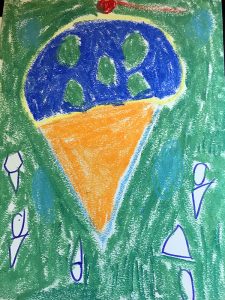
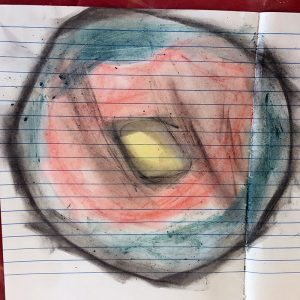
Minds On, Hands On
Teachers at Camp Innovate incorporate a lot of activities not only because their students are a wiggly, giggly, singing, whispering, bouncing group with a lot of energy; the activities also engage students in observing, wondering, discovering, thinking, and analyzing.
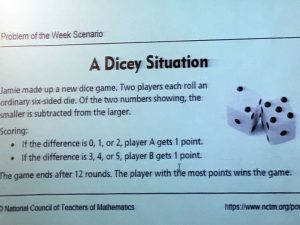 In Math on Tuesday, Kierra Chandler taught students about probability by having them analyze whether or not a dice game was fair (see photo). As the student played in pairs, rolling dice and keeping track of their points, they soon observed each Player A was accumulating more points than each Player B. When they finished, Kierra said, “First, let’s remember what fair means.” The class told her that it meant that both players had a fifty-fifty chance of winning. She then asked, “So, is the dice game fair?”
In Math on Tuesday, Kierra Chandler taught students about probability by having them analyze whether or not a dice game was fair (see photo). As the student played in pairs, rolling dice and keeping track of their points, they soon observed each Player A was accumulating more points than each Player B. When they finished, Kierra said, “First, let’s remember what fair means.” The class told her that it meant that both players had a fifty-fifty chance of winning. She then asked, “So, is the dice game fair?”
One student answered, “No, because player A had more chances to get points — like you can get a zero with any two numbers that are the same, but there’s only one way to get a one — if you roll a six and a one.”
Sierra directed them to investigate the different ways you can roll various numbers in the game, and they confirmed that Player A did indeed have more chances to score than Player B, making the game unfair. She then asked each pair to figure out one change they could make to the rules to make the game fair and to test out their change.
One pair tried adding instead of subtracting, but they quickly observed the game still was not fair. Another pair decided whoever rolled the higher number would get a point, and on testing their rule found they had created a fair game. With a roll of the dice — and by testing, observing, and analyzing — the students had experienced — and learned — the concept of probability.
In Clowning, teacher Nick Wilkins introduced juggling to his students on Tuesday by drawing diagrams and demonstrating tosses and catches with leather bags and scarves. There is no such thing as clowning by whiteboard, however, so the real work began when the students spread out across the room with their own bags and scarves.
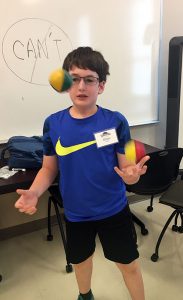
At first, juggling may seem to be all about hand-eye coordination, but as Nick made his way through the class, adjusting the students’ techniques, it was clear that there was a lot of thinking going on as well. Students had to understand why to throw the bag at an angle rather than straight up, why they needed to throw to head level rather than up to the ceiling, and why they needed a rhythm of one-two-catch. They also had to develop the confidence to keep trying and believe that they could eventually master the skill, no matter how many times a bag fell to the floor.
Throughout the process, Nick encouraged persistence and adjustment. “We changed that pattern for the good,” he told one student. “You’re changing, we’re changing, I love it!”
When another student made a big improvement, he joked, “Your wife will be very impressed — I mean your mother.” The students laughed, and then they kept juggling — testing, applying, and rethinking their ideas as well as their bodies.
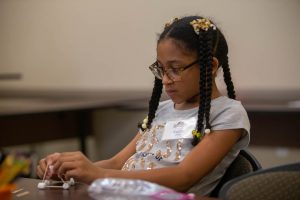 As in Clowning, in Science, hearing the explanation of a concept is not as effective as testing it out for oneself. The class spent Tuesday focusing on Newton’s Laws with activities that used the concepts of mass, acceleration, force, and motion.
As in Clowning, in Science, hearing the explanation of a concept is not as effective as testing it out for oneself. The class spent Tuesday focusing on Newton’s Laws with activities that used the concepts of mass, acceleration, force, and motion.
After a review of vocabulary where she had students move their bodies as they repeated definitions, teacher Amelia Watkins explained they would work with the formula force = mass x acceleration. Their activity would let them investigate how mass, acceleration, and force interact and required only a wooden ruler, a ping pong ball, and a golf ball.
First, they talked about how the balls are different, determining that the ping pong ball is hollow and lighter and the golf ball is solid and heavier. Then, each small team bent a ruler back the same distance for each type of ball and observed how the responses from the balls differed. Next, they adjusted how much to bend the ruler so that they could achieve the same acceleration with each ball.
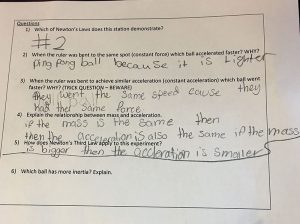 After writing down their observations, they analyzed what they had seen. “Think about speed and force,” Amelia said. “How did you change what you did with ruler to get the same speed from the two different balls?” The students definitely enjoyed getting to flick rulers and send balls rolling around the classroom — but they were also able to answer questions about Newton’s Laws, force, mass, and acceleration (see photo).
After writing down their observations, they analyzed what they had seen. “Think about speed and force,” Amelia said. “How did you change what you did with ruler to get the same speed from the two different balls?” The students definitely enjoyed getting to flick rulers and send balls rolling around the classroom — but they were also able to answer questions about Newton’s Laws, force, mass, and acceleration (see photo).
At Camp Innovate, teachers make sure their lessons allow gifted students to go as far and as fast in their learning as they want. Student choice and minds-on, hands on activities give students the power to discover.
